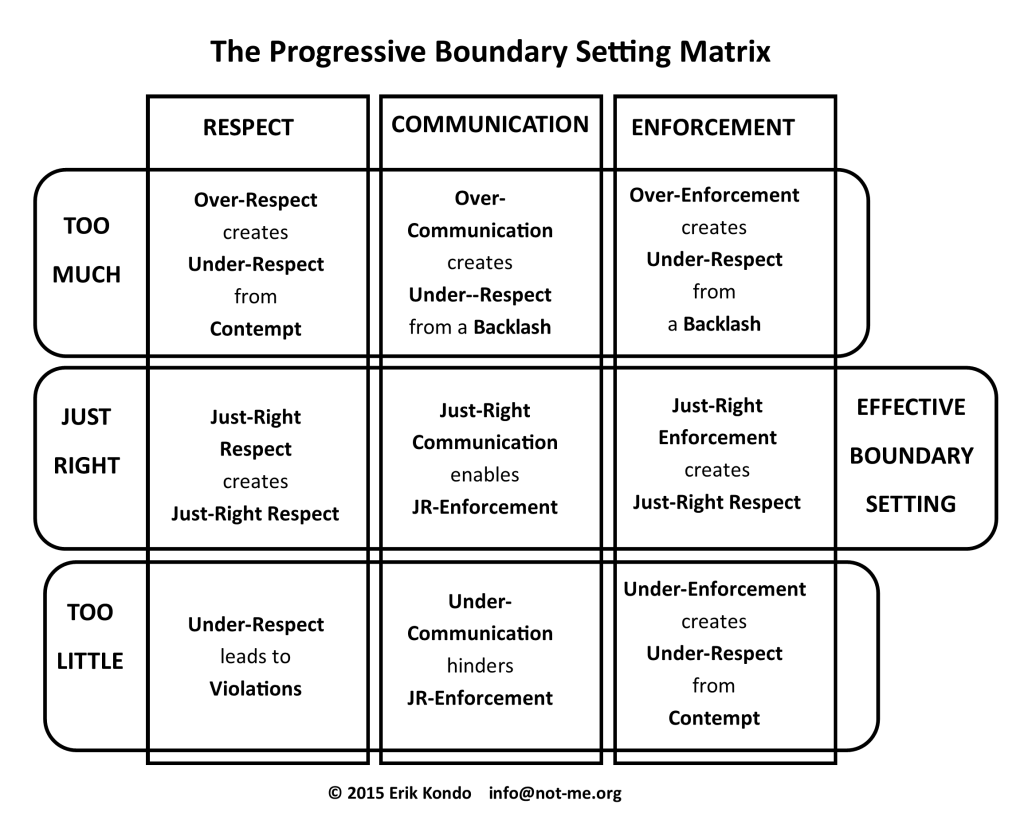Nothing is certain in life except for death, taxes, and boundary setting. Most human interpersonal and societal relationships are based on some variation boundary setting. So unless you are a lifelong hermet, you have been using boundary setting since early childhood.
While boundary setting is a natural action that people do in various ways. Effective boundary setting is not instinctive. It is a learned skill that takes practice and continual evalution of feedback.
Despite the importance of boundary setting in everyday life, particularly in reference to conflict management, this skill is not well understood. Most people think that boundary setting simply refers to their personal “space bubble” and that’s about as deep as it gets. While in fact, it spans from personal space to parenting to policing to politics and beyond.
The purpose of the Progressive Boundary Setting Matrix is to provide you with a framework for understanding the concepts of boundary setting in an organized manner. It allows you see how everyday occurances described by common phrases such a “draw a line in the sand”, “create respect for the law”, “set an example”, “a disporportional response”, “set a precedent”, “teach a lesson”, “too permissive”, etc are all boundary settng concepts.
The Matrix allows you to better organize your thoughts, opinions, and experiences regarding boundary setting. It is a tool to enhance performance. And like most tools, if it doesn’t work for you, then you don’t have to use it.
The Progressive Boundary Setting Matrix is based on several basic ideas.
- Most actions can be categorized under the Goldilocks Principle of Too Little or Just-Right or Too Much for the situation. This is the concept of balance and appropriateness. It is also the described by the inverted U-Curve.
- When it comes to human beings, every action doesn’t always result in an equal and opposite reaction. Actions that are either Too Little or Too Much, many times result in a greater response creating escalating consequences.
- The purpose of Boundary Setting is to control and limit unwanted behaviors in order to create trust and security in society and for individuals.
- Boundary Setting is a fundamental aspect of civilization. Boundary Setting occurs in most areas of people’s lives from families to employment to international relationships and more.
Boundary Setting starts with the creation of the Rules of behavior. These Rules must be clearly COMMUNICATED to others. Clear communication of the Rules avoids violations of the Rules by people misunderstanding the Rules. When all people understand the Rules, those that violate the Rules, are the ones that don’t RESPECT the Rules. Those that respect the Rules also follow the Rules.
Violations of the Rules require the use of JUST-RIGHT ENFORCEMENT in order to create respect. Appropriate enforcement serves as a deterrent for future violations. But Over-Enforcement of the Rules is Too Much. It creates a Backlash against the Rules, which increases Lack of Respect for the Rules. This reaction is human nature at work. If the Violator believes that a Rule has been Over-Enforced, he or she will feel unjustly treated. As a result of this emotion, the Violator will now feel less respect for the Rules. And he or she will now be more willing to violate.
If the Violator feels that a Rule has been or will be UNDER-ENFORCED, then there is insufficient deterrence to change the Violator’s behavior. The Violator will feel Contempt for the Rules. As a result, he or she may continue his unwanted behavior.
An important issue is that what constitutes the appropriate level of enforcement needed to create respect is mainly in the eyes of the Violator. The systemic application of Just-Right Enforcement requires that both the Violator and the Enforcer agree on what level of enforcement is appropriate for any given level of violation.
This agreement results from clear communication regarding the rules of behavior, violations, and associated punishments. Structural disagreements and miscommunication about these issues will cause the boundary setting to fail regardless of the actual appropriateness (as deemed by outsiders) of the enforcement.
Common causes of miscommunication are emotional thinking and pre-existing bias. When people in a conflict become emotional their ability to send and receive communication becomes impaired. Alcohol has the same detrimental effect. People with fixed cultural, gender, and ideological bias see the world differently than those with other belief systems . These are all causes of miscommunication which leads to boundary setting failure.
The Progressive Boundary Setting Matrix shows that effective Boundary Setting systems must contain a Just-Right level of Respect, Communication, and Enforcement. Any other combination will cause the system to become unstable. It will not control unwanted behaviors. Each of the three fundamental components of Respect, Communication, and Enforcement can be subdivided into three separate categories of Too Little, Just-Right, and Too Much. Ineffective Boundary Setting systems invariably apply Too Little and/or Too Much.
The world consists of overlapping boundary setting systems. Within all these systems, there are those that work well, and those that don’t. Systems that work use a Just-Right combination of Respect, Communication, and Enforcement.

